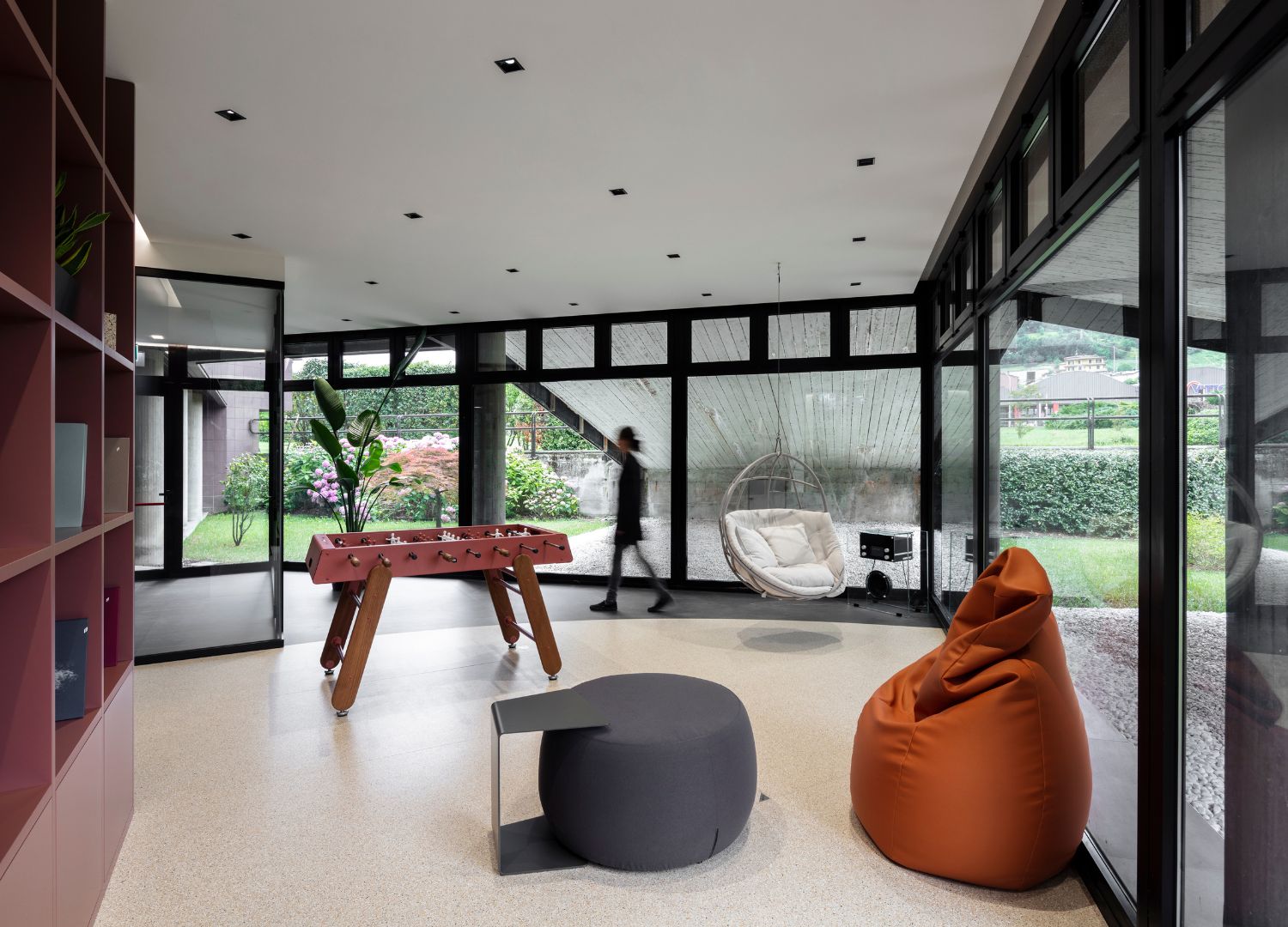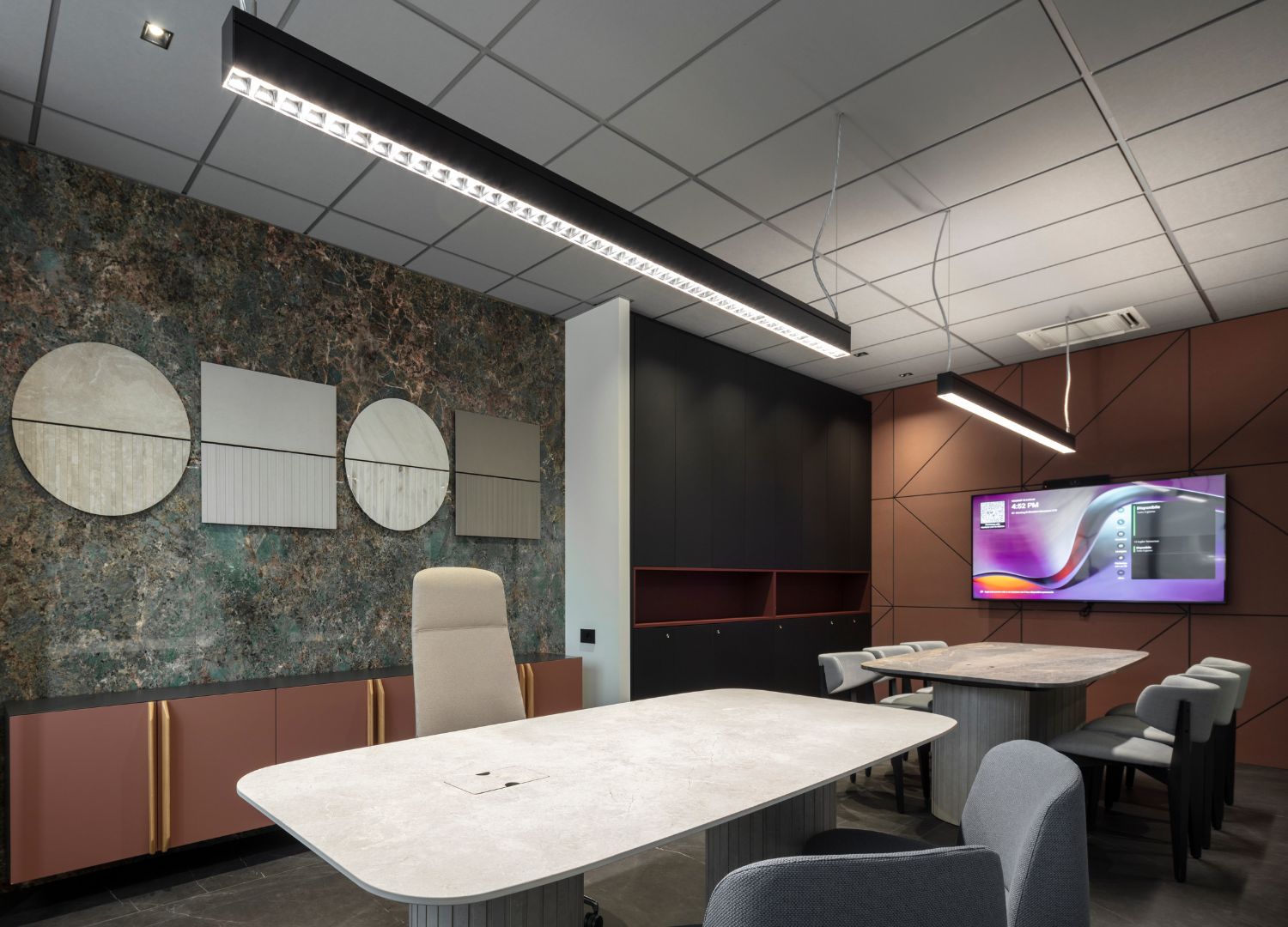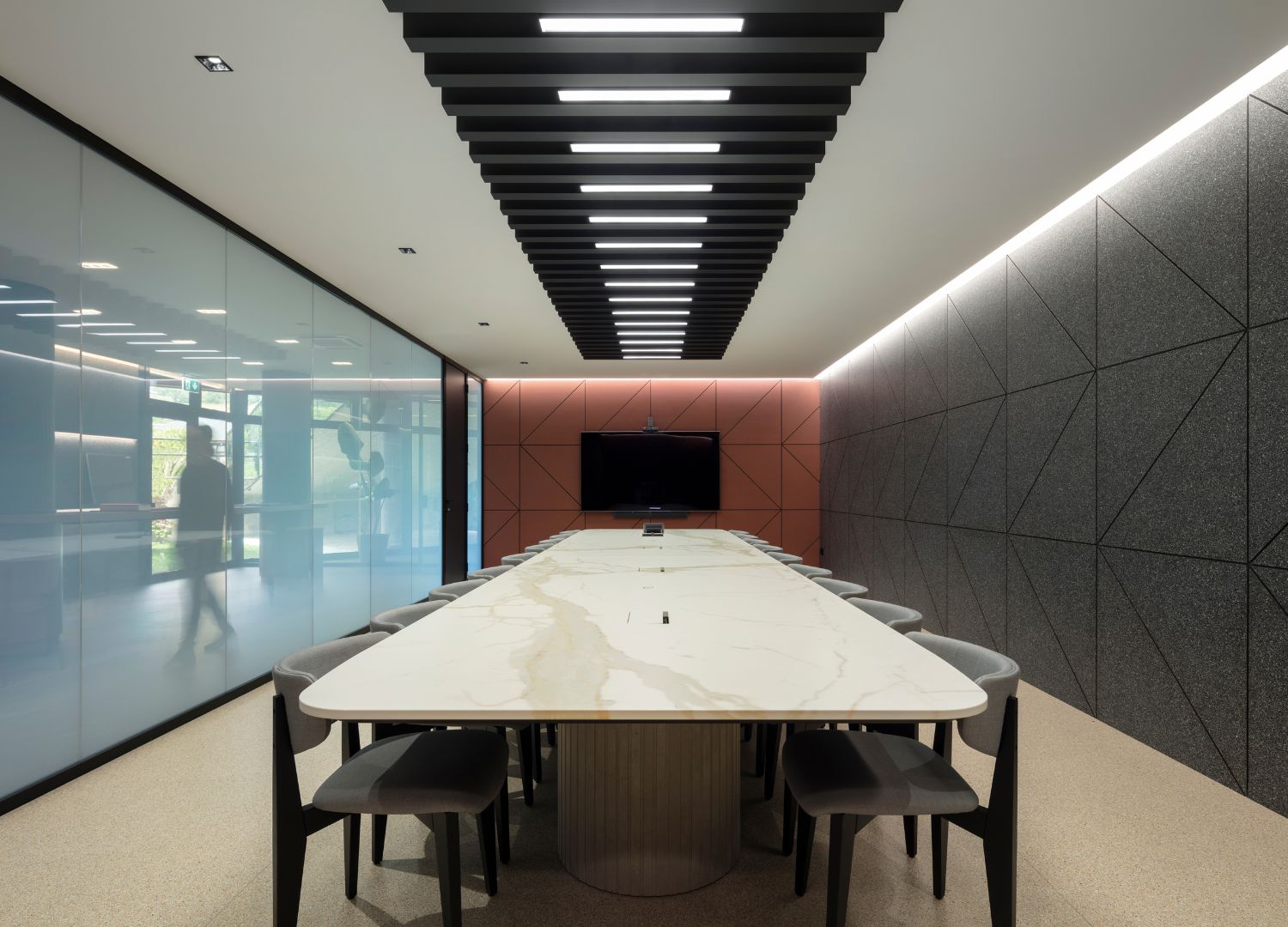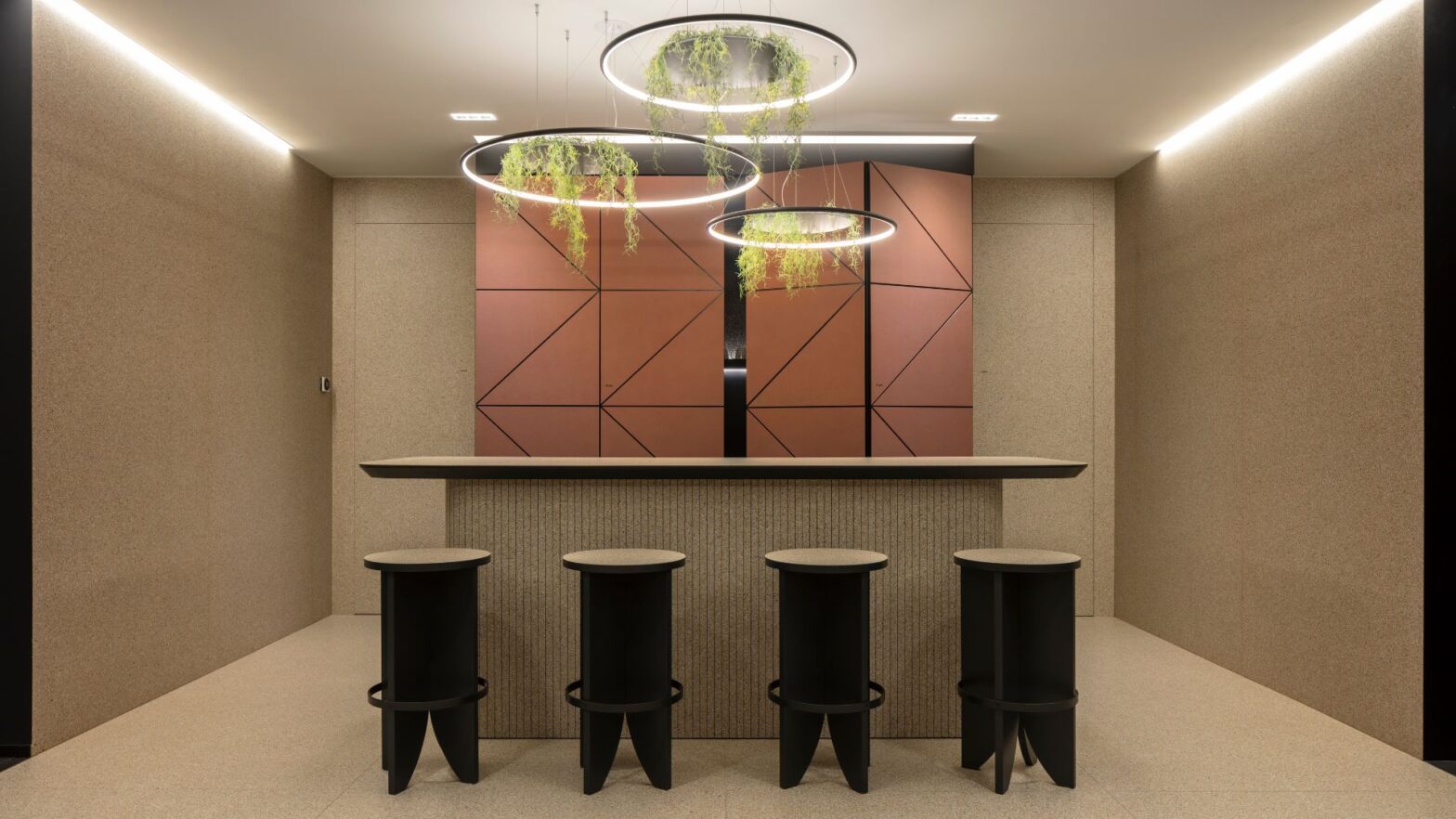How much time do we really spend working? More than we spend at home. However, it is becoming increasingly difficult to find a balance between work time and personal time. The boundaries between professional and private life have never been so fluid. While this mixing can cause stress, it also presents an opportunity to rethink the design of our workspaces.
Office design is undergoing a profound change: it is no longer just about desks, chairs and computers. Nowadays it's about creating environments that combine common spaces, relaxation areas and private zones. This philosophy has been expertly implemented by Iosa Ghini Associati in the redesign of Fiandre's historic headquarters in Castellarano (RE), the brand for high-quality ceramic surfaces Iris Ceramica Group housed in an impressive 2,400 M2 Building extends over three floors.


How Fiandre HQ prioritizes wellbeing and long-term benefits
While from the outside the Fiandre headquarters appears to be a postmodern building combining contrasting materials such as glass and brick, inside, ceramic surfaces transform the space and act as a dynamic “skin” that redesigns and enhances the surroundings. The aim of the redesign was to create a workplace that promotes the well-being of employees through the use of modern and high-quality materials. A key feature of this renovation is the widespread use of Active Surfaces®. From floors and desks to meeting tables, bar areas and service zones, these ceramic tiles are transformed into eco-friendly materials that ensure a high level of hygiene throughout the office.
Fiandre has always placed great value on sustainability and makes it a cornerstone of its design philosophy. Active Surfaces® technology is the result of long and innovative research into new solutions to improve the quality of life by combining cutting-edge functionality with aesthetic elegance. Developed by Iris Ceramica Group in collaboration with the Faculty of Chemistry at the University of Milan, these groundbreaking photocatalytic ceramics boast advanced properties including antibacterial, antiviral, anti-pollution, anti-odor and self-cleaning properties.
Choosing the right materials is more important than ever
Active Surfaces®' patented photocatalytic process continuously breaks down harmful pollutants such as nitrogen oxides (NOx) and volatile organic compounds (VOCs) and purifies the air both in the building and in the surrounding area. This process is activated by light and humidity, ensuring effectiveness even with artificial lighting, including energy-efficient LEDs. The result is cleaner air, a healthier atmosphere and a more sustainable architectural approach.


We need to be able to live our everyday spaces safely and freely without compromising on design. That's why the choice of materials can make a difference. Active Surfaces® not only have a high design value, but are also an innovative answer to our need for safety and well-being. Made from high-quality porcelain stoneware, it combines durability with maximum functionality and offers long-term benefits with minimal maintenance.
Ceramic surfaces give all rooms a modern flair
As you enter the main lobby, the basement contains offices, meeting rooms and a relaxed lounge area that opens onto a garden. The Active Surfaces® finished basement features Pietra Gray Maximum and Seminato Beige from the Il Veneziano collection, while the full-bodied Pulsar surfaces collection adorns the reception area, complemented by Venetian Active Surfaces® terrazzo chosen for the bar area furnishings.
On the mezzanine, visitors are greeted by an elegant, functional reception area that provides access to further offices and meeting rooms. The space is divided into three zones: the reception and two waiting areas, separated by elegantly curved walls. Both the desk and the sculptural backgrounds are made from Sapienstone. The Iris Ceramica Group's state-of-the-art 4D ceramic technology is used to seamlessly integrate the surface design into the body of the plate.
Glass partitions and intelligent systems: improving light, sound insulation and spatial permeability
In the office space, the interaction of durable materials such as porcelain stoneware and transparent glass creates a harmonious atmosphere. “The glass partitions allow natural light to penetrate deep into the building“ says the architect Massimo Iosa Ghini “Expands the sense of space and creates deep, perspective effects while ensuring sound insulation through glass partitions with high acoustic efficiency.” All upper cabinets feature sections covered in a different shade from the Marmi Maximum collection. To ensure maximum hygiene, all desks are covered with 12mm Sapienstone Platinum White Active Surfaces®.


The tables of the headquarters meeting rooms are made of Sapienstone 4D ceramics and are equipped with advanced lighting control systems and polarized windows, all controlled by Hypertouch® – an exclusive, intelligent system developed by Iris Ceramica Group. Applied to ceramic plates, this integrated system of sensors and touch controls ensures optimal lighting, eliminates the need for external switches or plates and maintains the purity of the design.
Design as a solution to unseen but urgent needs
Post-pandemic, offices have become more like our homes than ever, not just in terms of atmosphere or furnishings, but also in the way we perceive surfaces – Can I sit safely in this chair? Who used this desk? For this reason, it is more important than ever to carefully consider the materials we choose when designing and constructing our spaces. While the social distancing measures imposed by the pandemic are now behind us, the need for hygienic, safe surfaces is far from over.
What if design could be the ultimate key to fighting viruses and bacteria? As Fiandre's Active Surfaces® demonstrate, the focus on materials in offices and common spaces has evolved from a secondary concern to a critical one. In fact, design is no longer just an aesthetic matter; It is a practical response to silent but urgent challenges, a way to make the invisible visible.
